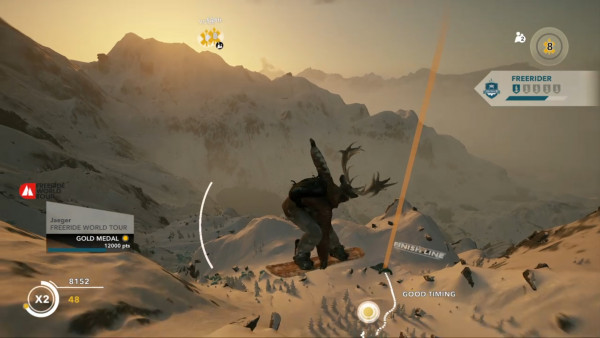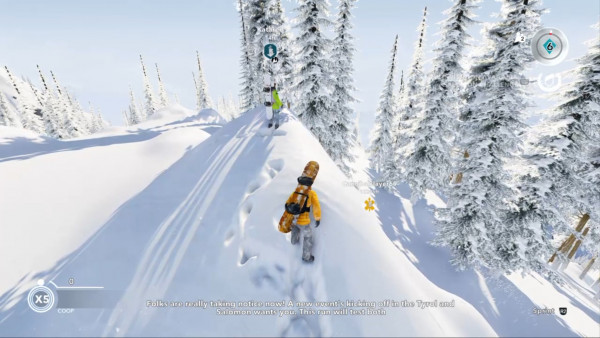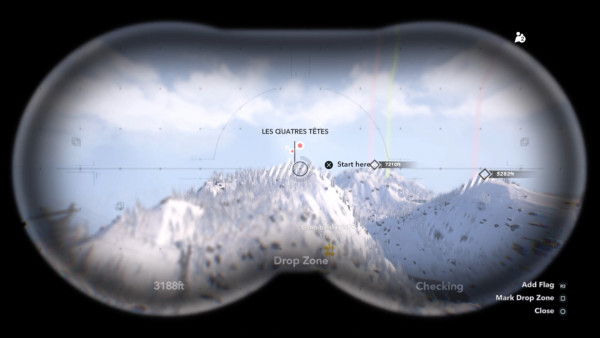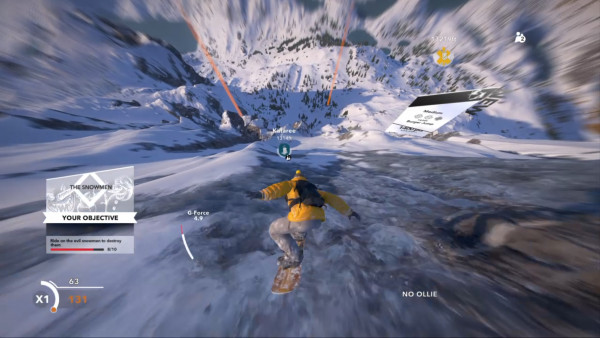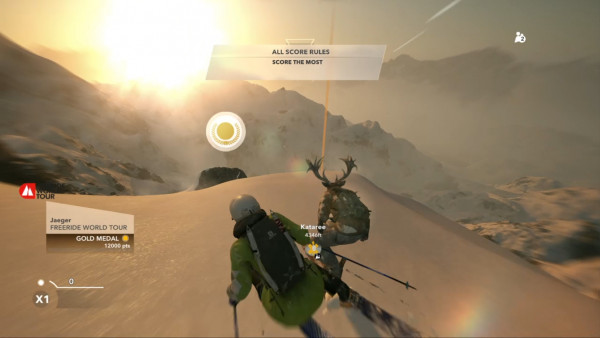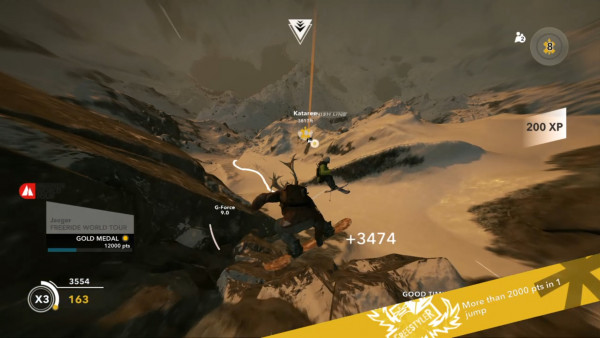Steep PS4 Beta Impressions: A Winter Sports Wonderland

You’ve finally found it, the perfect ride. You’ve trekked for hours across Aiguilles and the twCursed Mountains to find it, climbing up cliff faces and gliding back down, but here it is. A beautiful jump sits before you, sitting just above a ravine. You could surely handle this and perhaps set some new records in the meantime. Snow glints off of the trees, but not into your eyes. This is the perfect time to make an attempt. You issue a challenge and begin your descent down the mountain.
As the jump draws nearer, you hunch over and prepare to launch off. You make the jump and do a 1440° spin, but you didn’t get enough air and you’re about to clip a rock. You spin slightly, narrowly avoid it, and barely land safely just beyond another rock in the cliff face. You’ve done it. You’ve set a new record for sure...and then you fly right past the finish line and lose your high score.
I won’t lie to you. Steep has had me yelling at my TV screen as I have done exactly what I described above. It’s an inherently frustrating turn of events that is made even more frustrating by the fact that you know it’s your fault. The game gave you every chance to succeed and yet you chose to go for the route that you simply couldn’t use to make it to the finish line in time. But let’s step back for a second.
The latest in Ubisoft’s line of pseudo-MMOs, Steep is a winter sports wonderland of sorts in which you can freely run through a subsection of the Alps by skiing, snowboarding, paragliding, or wingsuit flying. You can also simply walk around, but where’s the fun in that? The game’s Open Beta doesn’t begin until November 18th, but I managed to snag early access, so I’m going to share some impressions with you.
When you first start Steep up, you’re dropped into a guided tutorial. The game runs you through everything you need to know to play, makes you play one of the Steep Invitational events, and then finally allows you to enter the open world with other players and do whatever you want. When I say “do whatever you want,” I really mean it. Other than a flimsy story and some impromptu challenges that the game throws at you based on the region you’re currently in, you can explore wherever you want, find drop zones, unlock challenges, and gain access to quite a lot of content without following the story. I’m sure this isn’t true of all of the game’s content, but I’ve not followed the story beyond the initial steps and I’ve had hours of content at the ready ever since.
You find new content by simply exploring. The game gives you a pair of binoculars that you can use to scope out the area. You can see drop zones and points of interest and even place markers on them, should you want to remember where they are. After that, you just pick a mode of play and head out to it. If you want to hike the whole way, you can even do that, but it will be an extremely slow process, as the game does fairly well at realistically modeling the speed at which someone can trudge through the snow.
The world is fairly wondrous and the immense scale of each mountain is unparalleled in many games. The team at Ubisoft did a great job of making you feel small in a giant chain of mountains. The problem is that fast travel ruins that sense of scale entirely. There’s no limit for fast travel, such as forcing you to have to see your destination via the binoculars. You can simply pull up the map and fast travel to any location you’ve unlocked or any ride you have saved. This essentially limits the amount of exploration you will actually have to do, as you won’t have to go far out of your way to get to the next drop zone. You can simply travel to the drop zone—or challenge, even—nearest to the one you want to get to, put on your wingsuit or paragliding gear, and get there in no time. You could experience the world as it is and trudge realistically through the snow and climb entire mountains to get close enough to drop zones to unlock them, but there’s little incentive to do so, as it takes quite a long time by comparison and there are no additional rewards for time invested in the endeavour.
In terms of realism, those that have played The Crew will have a good idea of what they’re in for. Steep utilizes an odd midway point between realistic and arcade gameplay that can be awkward at times, but the issues I’ve had are fortunately not frequent. There are a number of times that I’ve tried to ramp off of a half-pipe, only to be glued to the top of the half-pipe in a manner that is perpendicular to the way I was, or that I’ve gone into the air and tried to do a trick, only to find that I didn’t choose a direction to move the left stick in at exactly the right time, now leaving me with no momentum in midair, but, for the most part, it works out. The system for doing tricks feels limited, giving you the options to do spins, flips, and grab your board in midair, as well as giving you bonus points for close calls, but it gives you enough to work with overall.
Perhaps the oddest part of Steep’s pseudo-realism is the knockout system. When you hit the ground—or a rock or a tree or a fence—you endure a certain amount of G-force, which can increase or decrease depending on how you land. When you endure enough Gs that your health bar is depleted, you turn into a ragdoll and go rolling down whatever hill you’re on until the physics engine decides that you’ve fallen far enough and lets you come to a stop and get back up. While in this state, if you hit something hard enough, you can be knocked out, forcing you to restart your current challenge. The conditions that result in a knockout seem inconsistent at best. Sometimes, you’re knocked out immediately upon hitting a rock, whereas other times, you can hit a rock, roll all the way down the hill, and get back up. The worst part about this isn’t even the chance of being knocked out. It’s that, as you are rolling down the hill, you are being penalized in the form of missing jumps that could give you valuable airtime. If you don’t end up in a spot where you can get back up quickly, it’s basically the end of your chances at getting gold during that challenge run. However, this is only a minor annoyance and mapping out a good route for the ride that you’re currently attempting to complete a challenge on is the best way to avoid knockouts altogether.
Where Steep really falls flat is its multiplayer gameplay. All of Steep’s structured challenges take place in the open world. You run through a checkpoint that marks the beginning of a run that has a challenge attached to it and the challenge begins. Almost all of them consist of beating a specific score of time. When you’re playing alone, it works really well. If you’ve yet to get a specific medal, a pre-created ghost that follows a route that could get you that medal will appear, its route visible throughout the challenge. If you’ve already obtained a gold medal for that challenge, your top scoring route will appear instead and you’ll be up against a ghost of yourself.
However, when you join a group, you can’t replace that ghost with other players. You can challenge each other through a private group leaderboard, running the challenge over and over until someone concedes, but there’s no more to it. There’s no system in which they ensure fairness by starting the entire group at a specific point at the same time. Everything about multiplayer challenges is sort of impromptu and disconnected. Yes, you are playing with your group and yes, you can see what they’re doing at all times, but you can’t directly interact with them—not even in your own, handmade challenges.
That being said, the system for creating your own challenges is incredibly cool. Challenges are created from your rides. You simply start a ride by changing your current mode of play, ride your way to the end point, pull up the map, choose a challenge to attach to that ride, and it’s done. The game will auto-generate checkpoints based on your ride and you now have a whole new challenge that you can share with friends. I have never seen such a simple, intuitive system of creating challenges. The only issue I have with it is that it offers little control over the finer aspects of challenge creation and I’ve experienced some extremely awkward checkpoint placements, such as right on top of a rock at the bottom of a hill.
I went into Steep expecting the winter sports version of The Crew, a game I enjoyed quite a bit because of its pseudo-MMO style and open world multiplayer gameplay, allowing players to join together and play through the entire campaign in a multiplayer setting thanks to instanced races. I got quite a bit of what I expected, though, unfortunately, the game doesn’t offer the same level of multiplayer interaction. I’ve been enjoying the game quite a bit and, even though I likely won’t keep my progress, I’ve been working to get a gold medal on every challenge I play and exploring as much as I can. Despite its faults, the game compels you to do better, constantly throwing yourself off of cliffs in an effort to get the highest score, and incorporates a healthy dose of exploration, as well, leaving you constantly asking “what’s just over that ridge?” It’s a game that had me yelling at the TV, angry at myself for just barely clipping a rock and getting knocked out, which is rare occurrence these days. Something about it gripped me and the Beta has me eager to play more.
